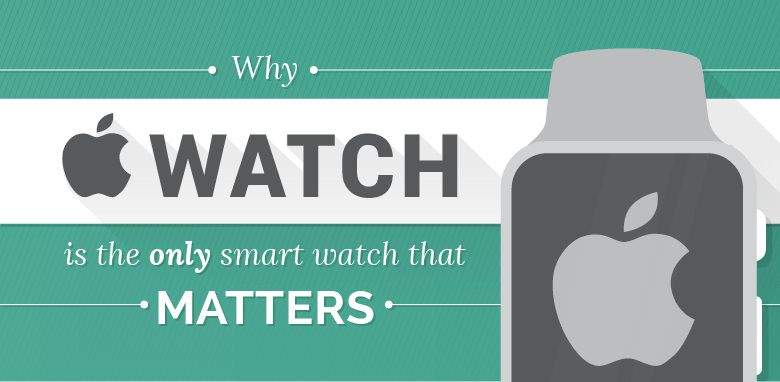Technology
Why Apple Watch is the Only Smartwatch That Matters

Why Apple Watch is the Only Smartwatch That Matters
Apple’s business model has famously focused on proprietary ecosystems to maintain maximum control over how a product is designed and marketed to consumers. When the company whiffs on a design, it can lead to one of their many product flops.
However, when Apple hits the nail on the head, it can be a game-changer.
Before the launch of the Apple Watch, there was much debate among analysts as to whether it would even move the needle on revenues for such a massive company. Many took the position that although it would be big, that sales of the Apple Watch would not compare to other devices.
Slice Intelligence, a company that data mines email receipts, so far estimates that Apple Watch sales as of mid-June were about 2.79 million. Further, about 17% of shoppers bought more than one high-margin band for the watch. Business Insider notes that the second-most popular second band is the more luxurious Milanese Loop, which sells for a lofty $149 and costs Apple just a fraction.
The above infographic shows that it took 74 and 24 days to sell the first 1 million iPhone and iPad units. Meanwhile, it only took one day for Apple Watches to reach the same milestone. That’s more sales in one day than Android Wear did in the whole of 2014.
Tim Cook said in an interview with Fast Company that the Apple Watch is the first smartwatch that matters. Based on initial sales numbers, this appears to be true. Android’s diversity of hardware makers and fragmented ecosystem has its advantages, but when it comes to entering a new category sometimes it is better to swing for a home run.
What is less clear, however, is whether the Apple Watch will ultimately have a big enough impact to provide a catalyst to the company’s stock price. As of now, $AAPL is still hovering around a $715 billion market capitalization, which is still falling short of the technology company’s quest to hit $1 trillion in value.
Enjoyed this infographic? Check out 37 Surprising Facts About Apple.
Original graphic by: MobileSiri
Technology
Visualizing AI Patents by Country
See which countries have been granted the most AI patents each year, from 2012 to 2022.

Visualizing AI Patents by Country
This was originally posted on our Voronoi app. Download the app for free on iOS or Android and discover incredible data-driven charts from a variety of trusted sources.
This infographic shows the number of AI-related patents granted each year from 2010 to 2022 (latest data available). These figures come from the Center for Security and Emerging Technology (CSET), accessed via Stanford University’s 2024 AI Index Report.
From this data, we can see that China first overtook the U.S. in 2013. Since then, the country has seen enormous growth in the number of AI patents granted each year.
| Year | China | EU and UK | U.S. | RoW | Global Total |
|---|---|---|---|---|---|
| 2010 | 307 | 137 | 984 | 571 | 1,999 |
| 2011 | 516 | 129 | 980 | 581 | 2,206 |
| 2012 | 926 | 112 | 950 | 660 | 2,648 |
| 2013 | 1,035 | 91 | 970 | 627 | 2,723 |
| 2014 | 1,278 | 97 | 1,078 | 667 | 3,120 |
| 2015 | 1,721 | 110 | 1,135 | 539 | 3,505 |
| 2016 | 1,621 | 128 | 1,298 | 714 | 3,761 |
| 2017 | 2,428 | 144 | 1,489 | 1,075 | 5,136 |
| 2018 | 4,741 | 155 | 1,674 | 1,574 | 8,144 |
| 2019 | 9,530 | 322 | 3,211 | 2,720 | 15,783 |
| 2020 | 13,071 | 406 | 5,441 | 4,455 | 23,373 |
| 2021 | 21,907 | 623 | 8,219 | 7,519 | 38,268 |
| 2022 | 35,315 | 1,173 | 12,077 | 13,699 | 62,264 |
In 2022, China was granted more patents than every other country combined.
While this suggests that the country is very active in researching the field of artificial intelligence, it doesn’t necessarily mean that China is the farthest in terms of capability.
Key Facts About AI Patents
According to CSET, AI patents relate to mathematical relationships and algorithms, which are considered abstract ideas under patent law. They can also have different meaning, depending on where they are filed.
In the U.S., AI patenting is concentrated amongst large companies including IBM, Microsoft, and Google. On the other hand, AI patenting in China is more distributed across government organizations, universities, and tech firms (e.g. Tencent).
In terms of focus area, China’s patents are typically related to computer vision, a field of AI that enables computers and systems to interpret visual data and inputs. Meanwhile America’s efforts are more evenly distributed across research fields.
Learn More About AI From Visual Capitalist
If you want to see more data visualizations on artificial intelligence, check out this graphic that shows which job departments will be impacted by AI the most.
-

 Markets1 week ago
Markets1 week agoU.S. Debt Interest Payments Reach $1 Trillion
-

 Markets2 weeks ago
Markets2 weeks agoRanked: The Most Valuable Housing Markets in America
-

 Money2 weeks ago
Money2 weeks agoWhich States Have the Highest Minimum Wage in America?
-

 AI2 weeks ago
AI2 weeks agoRanked: Semiconductor Companies by Industry Revenue Share
-

 Markets2 weeks ago
Markets2 weeks agoRanked: The World’s Top Flight Routes, by Revenue
-

 Countries2 weeks ago
Countries2 weeks agoPopulation Projections: The World’s 6 Largest Countries in 2075
-

 Markets2 weeks ago
Markets2 weeks agoThe Top 10 States by Real GDP Growth in 2023
-

 Money2 weeks ago
Money2 weeks agoThe Smallest Gender Wage Gaps in OECD Countries













